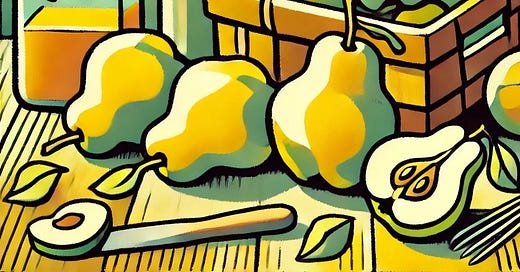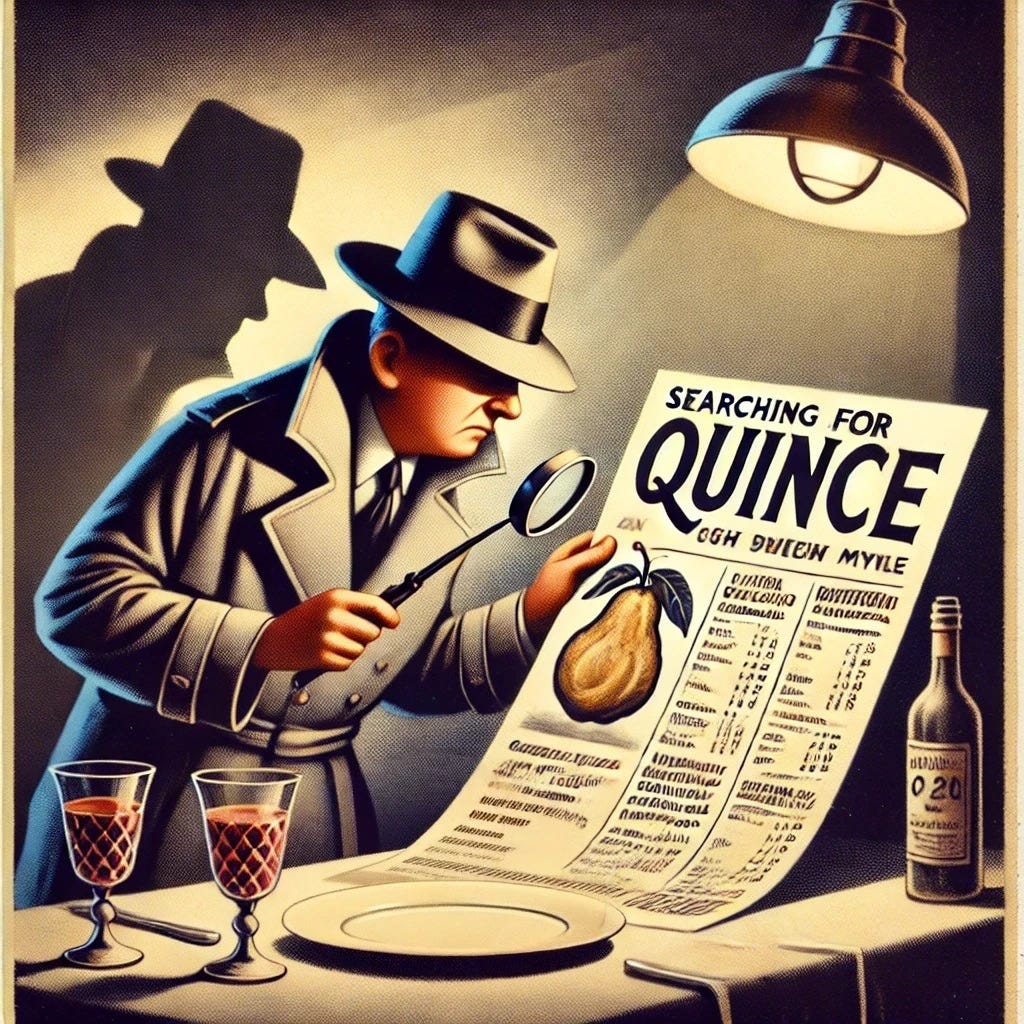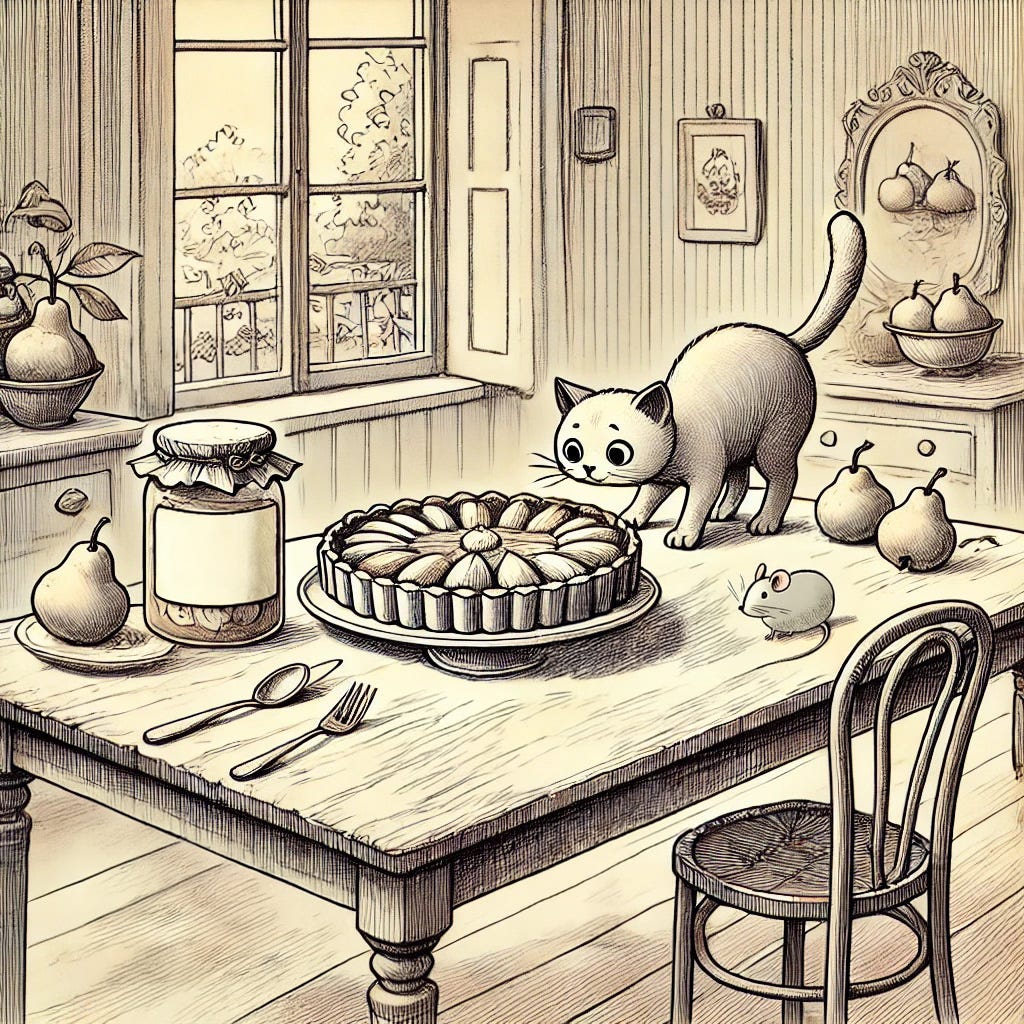Sunday E-dition: Rediscovering Quince, California's Forgotten Fall Fruit
By Georgeanne Brennan
Before we dive into Georgeanne Brennan’s exploration of the often-overlooked quince, we want to remind you that Napa Valley Features is a subscriber-funded publication. Without support from new and recurring paid subscribers, stories like this could be scaled back or the entire publication could be forced to close. If you value our ad-free, conflict-free veteran-owned local reporting, please consider becoming a paid subscriber. For as little as 16 cents a day, you can help keep local news independent, relevant and sustainable.
NAPA VALLEY, Calif. — I think my fascination with quince began, like many things in my life, when I was living in Provence, raising goats and making goat’s milk cheese. One of my neighbors was from Calabria, having come to Provence at the end of WWII with her family as a young girl. She and her husband, a tenant farmer, grew their own fruits and vegetables, raised a pig for yearly provisions and kept rabbits and chickens. One day when I went for a morning visit, I found her in the kitchen spreading a thick, rose-orange colored substance into a pan. I had no idea what it was. She gave me a taste on the end of a knife. Sticky, sweet, dense, with a hint of apple but not apple. Pâte de coing. Quince paste. She explained it needed to dry out and firm up, that it would probably be ready the next morning.
I had no idea what a coing might be or look like and asked her to describe it. She took me down the stairs and behind the house to the edge of a vineyard below, where just beyond the low stone wall, next to the well, was a large, gnarled tree, its long branches weighted down with lumpy, yellow fruit. She hiked up her skirt, climbed over the wall and picked one of the fruits.
Sticky, sweet, dense, with a hint of apple but not apple... Pâte de coing. Quince paste.
“C’est un coing,” she said, handing it to me. It was heavy, apple-like, but larger, with a light fuzz. I could smell the intense aroma immediately.
“Don’t bite into it, it has to be cooked first,” she said.
They next day she brought me a little wax-paper block and explained that when I wanted to eat it, I should cut it in squares and roll it in sugar. It was a welcome treat for my little family.
I next encountered quince in California at a winery in the Anderson Valley (I don’t remember which one). I was there on a photo shoot for my first major book, “Potager.” There, grouped together on one of the lawns, were several quince trees, less gnarled and shorter than the Provencal tree, but undeniably quince. The photo John Vaughan took didn’t make it into the book, but I was given a few fruits to take home. I tried to make Pâte de coing, having found a recipe for it, but, after four days when it still hadn’t gelled, I gave up.
Despite my failed paste, I remained fascinated by quince, and when I spotted some growing near a long-abandoned homestead not far from where I live today, I asked my husband if he could get some cuttings. It’s been ten years, and the cuttings are now sturdy trees.
Fresh quince can sometimes be found at farmers markets, the produce section of specialty markets or growing in a friend or neighbor’s yard. A few years ago, the local culinary instructor here in Winters, where I live, wanted his class to make membrillo. He put out a call to the community for the fruit, and he received more than enough donations for his project, including some from me.
Maybe that tide will turn if quince starts appearing on restaurant menus.
This year, in early October, I harvested over thirty pounds of quince from my trees and took them to Taylor Boetticher at Fatted Calf in Napa. He said he’d be making some mostarda with them and braising others in duck gelee (the intensely flavored gelatin produced by duck confit), adding some walnuts and other ingredients to make a stuffing for pork roasts. Now that I want to try!
Membrillo can usually be purchased wherever there is a serious cheese counter, and of course, you could make your own. For me, I’ll stick to purchasing it.
Instead, with my quince, I’ll make my version of a Quince Tarte Tatin, sauté some with onions and apples to spoon alongside thick, pan-fried pork chops and make quince chutney to serve with the Thanksgiving turkey.
Unlike today, the fruit used to be popular. It was a common tree for small home orchards, or even a single tree for town dwellers. It has a high pectin content and was valued as an addition to jams and jellies to add in thickening.
Since commercially produced pectin is readily available today, it seems there’s not much of a market for the fruit, except for people like Taylor. Maybe that tide will turn if quince starts appearing on restaurant menus.
Tarte Tatin of Quince and Apples
Tarte Tatin, an upside-down apple tart, can also be made with quince. The addition of currants or raisins adds extra interest and flavor, as does marinating the fruit in a mixture of wine or brandy and sugar. This recipe first appeared in my book, Savoring France.
4 large or 6 small yellow quinces
4 Golden Delicious or Granny Smith apples
2 cups dry red wine such as merlot
1 cup sugar
1 piece vanilla bean (about 2 inches long)
1 cup currants or golden raisins
2 tablespoons butter
1 prepared pie pastry for 9–10-inch pie, either purchased or homemade
Peel and core the quinces and apples and cut them into slices about 3/8 inch thick. Place them in a bowl with the wine, ½ cup of the sugar and the vanilla beans. Cover and let stand at least 8 hours, and preferably overnight before using.
Preheat an oven to 375 degrees Fahrenheit.
Prepare a 9- or 10-inch baking dish that is 2 to 2 ½ inches deep by heavily buttering the bottom with 1 tablespoon of the butter. Sprinkle ¼ cup of the remaining sugar evenly over the bottom.
With a slotted spoon, remove one-third the quince and apple slices from the wine marinade. Arrange these slices in a single layer on the bottom of the dish. Add one-third of the currant or raisins and one-third of the remaining sugar. Repeat the process twice. Cut the remaining 1 tablespoon of butter into small bits and dot them over the top.
Roll out the pastry dough to a circle 1 ½ to 2 inches larger than the baking dish. Drape the pastry over the fruit, allowing it to droop over the edges. Tuck the crust down around the fruit, then back over the rim of the dish. Trim, if necessary, then pinch slightly to make a decorative edge. Prick the top with the tines of a fork. Bake in the preheated oven for 45 minutes to 1 hour. When the tart is done a thick syrup will have formed in the bottom of the dish, and the crust will be a deep golden brown.
Remove the tarte and let it cool about 5 minutes. Run a knife along the edge to loosen any bits of stuck dough or fruit. Invert a serving platter on top of the baking dish and, holding the platter and baking dish firmly, flip them. Serve warm.
Serves 6 to 8
Quince Chutney
This recipe was originally developed by Roxanne O’Brien for a dinner at my wine bar, L’Apero les Trois, and included dates. I’ve omitted the dates and tweaked a few other elements to produce this version.
3 pounds quince, peeled, quartered, cored, cut into 1/2-inch dice
3 cups brown sugar
1 cup apple cider vinegar
1 1/2 cups water
2 tablespoons finely minced fresh ginger
2 teaspoons ground coriander
1 teaspoon ground cardamom
1 tablespoon mustard seed, brown or black
1 cinnamon stick, broken in half
1 teaspoon sea salt
Zest and juice of 1 lemon
Combine quince, brown sugar, vinegar and water in a large heavy saucepan or Dutch oven.
Bring to a boil over medium heat, stirring occasionally. Lower heat to a simmer and cook for about 15 minutes. Continue to stir occasionally to watch liquid and prevent burning.
Add ginger and spices. Continue to simmer on low for 30 to 40 minutes, until the syrup starts to thicken. Add lemon zest and juice and cook chutney until thickened. Makes about 4 to 5 cups. (Adjust seasoning to balance acid, sweet and salt.)
Georgeanne Brennan is an award-winning cookbook author who divides her time between her farm in Northern California and a home in Provence. Learn more about her at her website.
If today’s story captured your interest, explore these related articles:
Sunday E-dition: Paws for Peace Supports Domestic Violence Survivors
Sunday E-dition: Napa's Haunting Spirits — A Ghostly Trilogy
Sunday E-dition: Calistoga and Its Library – a Century Long Retrospective
The Historical (And Personal) Significance of Mexican Independence Day
Levity Corner
Caption contest: Pick your favorite caption or add your own in the comments below.
Possible captions:
"Just one nibble… they’ll never notice."
"Temptation comes in many forms…”
"They never said curiosity wouldn’t get you dessert."
"You distract her, and I’ll go in for the tart."
"Two adversaries. One tart. Infinite possibilities."
Last week’s contest results
In “Sunday E-dition: Paws for Peace Supports Domestic Violence Survivors,” the winning caption was a tie between, “So… belly rubs for life, right?” and “I think this is the beginning of something beautiful,” each with 33% of the votes.
“So… belly rubs for life, right?”
“I think this is the beginning of something beautiful.”
“I didn’t think it would be this cozy in ‘our spot.’”
“Who rescued whom again?”
“Finally, someone who understands my need for pillow fortresses.”
Last Week
In “Under the Hood: Jennifer Bennett on Napa’s Changing Restaurant Landscape,” Tim Carl shared Bennett’s insights into the complex realities facing Napa Valley’s dining industry. Bennett, owner of Calistoga’s Lovina, discussed challenges beyond COVID-19, including rising operating costs, shifting consumer habits and staffing struggles, with local support remaining crucial. She described how a no-tip policy introduced at Lovina helped build team cohesion, while a new wine strategy focusing on high-end selections aims to offset declining wine sales. Bennett also highlighted her concerns about a potential minimum-wage increase, which could intensify cost pressures for restaurants already struggling to adapt in a post-pandemic market.
In "Gardening for Wellness," Cindy Watter reflected on how gardening became a source of mental and physical well-being during the pandemic. Watter shared her experience transforming her yard into a vibrant space for wildlife and a refuge for herself, finding that gardening’s physical demands and repetitive tasks offered exercise, relaxation and a sense of accomplishment. She observed that being in nature, watching birds and animals boosted her mood, linking outdoor activity with increased serotonin. Watter noted that gardening fosters community and resilience as seen in local gardens and school programs that inspire lasting positive memories.
In "Encountering Enigmatic Mountain Lions," Kathleen Scavone shared her experience capturing a mountain lion on her Middletown game camera and explored the presence of these elusive animals in Napa County. Scavone discussed how mountain lions, also known as pumas or cougars, live undetected in forested areas, feeding primarily on deer and other wildlife. Marain Smith of California's Department of Wildlife offered tips on keeping livestock safe and explained that while mountain lions pose little threat to humans, they can endanger pets and livestock. Jason Lombardi of CDFW added that Napa County’s habitat supports these large carnivores, although roadways limit movement across some regions.
In "Dan Berger's Wine Chronicles: The Depth and Versatility of Sangiovese," he explored the enduring appeal and complexity of sangiovese, a grape often misunderstood by American wine drinkers. Through a tasting with Michaela Rodeno, co-founder of Napa's Villa Ragazzi winery, Berger highlighted how sangiovese’s acidity and bright flavors allow it to age well and pair with diverse foods beyond classic pasta dishes. Berger also contrasted Villa Ragazzi's authentic, lighter sangiovese style with popular darker wines, noting that the winery’s unique clone produces intense, flavorful wines on Napa’s rocky soil. He praised Villa Ragazzi's sangiovese for its quality, value and dedication to traditional methods, positioning it among the best New World examples of this classic Italian variety.
Next Week
Next week we have more engaging articles from Napa Valley Features contributors. The UC Master Gardeners of Napa County will offer tips for “Green Wednesday,” while Tony Poer will explore the rarity of sauvignon gris at Chimney Rock. Tim Carl will report on Cook St. Helena’s 20th anniversary celebration and delve into Napa Valley's pest challenges, focusing on yellowjackets, ticks and other invasive species affecting outdoor spaces. More stories and insights will be included as well.











I love the illustrations! I could not be happier with them. Thank you, Napa Features! Georgeanne